








Travel report Nepal February/March 2009by Stefanie ChristmannIn February/March 2009, Stefanie Christmann, chairwoman of Esel-Initiative, visited the Manaslu region. To ease the climate-damaging effects of her flight, she made a donation to atmosfair.de. As always, the journey and all connected costs were financed privately. Many villages located around Manaslu are even poorer than those in the Annapurna region. The steep slopes make cultivation of fields almost impossible. Many women, like the widow Dil M. G. from Saleri (mother of two young children) are impoverished after losing their fields in a landslide. Many mothers are widowed because their husbands plunged to death while cutting wood on the steep slopes. Most villages consist of only 20 to 25 houses and are located in the mountains beside this 8000 m high peak. Harvests from this soil are poor. In addition, there are many wild monkeys who steal the harvest. The tracks around Manaslu are very narrow and all goods must be carried by mules or porters to the villages, which makes them quite expensive. In Bhi and Ghap (in a lower mountain region) rice costs already twice as much as in Mustang (Annapurna). Since the region is sparsely populated, there are no plans to build roads. Due to the absence of tourism, employment opportunities are very rare in the Manaslu region. When mountaineers come to climb Manaslu, even the single mothers try to get work as porters. The good news: In this sparsely populated and - due to its steep slopes - difficult to reach region, there is no organised trafficking in women (yet), which in the Annapurna region is mainly targeting young single mothers with false promises. The fathers of the children were mostly also day labourers without house or land. In the north, due to polyandry, many women never marry and lose their home when the parents die. Also in the Manaslu region, women, such as 44-year old Tsingsum L., live in rock caves. In winter, the snow gets into her cave and during spring, the snow melts and water enters her cave. With her nak, she is now able to rent a room. Despite the fact that she is living in a rock cave, her son is attending 5th year in school. Other mothers live in a three-wall shack with a rockface forming the fourth wall. In Nima T.’s case, the rock extends into the room. Mostly the house consists of one room with an open fire. The inhabitants sleep on the floor around the fireplace. Several widows have two, three or even five children for whom food, clothing and school fees must be paid. The daily wage for women in the Manaslu region is extremely low: They earn 50 cent to 1 € per day or are paid in grain. Some mothers sell grass, pine cones, pine needles, dung or wood. A lot more women than in the Annapurna region have to walk barefoot for several hours on rocky tracks. In some villages, the women’s clothes were held together only by the many applied patches. When asked what was the most important improvement provided by the allocated animal, most answered: “We can now eat more often tsampa (roasted barley porridge) instead of tsampa soup all the time”, “I can send my children to school” or “I can prepare rice pudding for my children before they go to school”. Almost all mothers want to use their income from the sale of grown calves or the double income from female calves to send at least one child to secondary school. In the Manaslu region, Sahayog Himalaya-Nepal (SHN) allocated water buffalos, donkeys and naks (female yaks) depending on the altitude. Forty-one year old Paria P., who lives in the green hills in the lower Manaslu region, received a water buffalo. This mother of two small daughters used to work in the fields of others or break stones for 1 €/day. She lived in rented accommodation (3 €/month). One month after she received her water buffalo, she took out a loan of 150 € and purchased corrugated iron to build her own house (from bamboo and corrugated iron). She is repaying the loan from her income selling milk and ghee. As she now also has dung, she has leased a field and started to grow vegetables. In the middle, less fertile region, 24 donkeys have been allocated by early March. As there have never been donkeys in the Manaslu region and only men worked with mules, SHN trained the mothers to pack the donkeys securely (for the goods) and gently (for the animals). With their animals the mothers received a stable protective blanket. As the donkeys are relatively small, they are only carrying loads of 40 kg in total. But the mothers are happy to no longer have to carry these 40 kg (of wood, dung or grain) themselves. Some use their donkeys for small journeys, e.g. to collect and sell wood, to carry stones or grain. Eight women around Eklaibhatti are planning to establish a donkey caravan for journeys lasting 8-10 days carrying goods from the road at the foot of Manaslu to the high mountain villages. One guide is sufficient to lead eight animals. These treks are providing good income in the Manaslu region. Since this work has previously only been carried out by men, a SHN volunteer will accompany the first transports to enable the women to have a good start. This is a big step, especially for the mothers from the mountain villages around Eklaibhatti. The group includes several self-confident older mothers and some very young women. Forty-year old Maili G. is one of the more experienced women. She is widowed with two young children at school. She works as a field worker and brews rakshi. In one month she produces 15 bottles which sell for 15-20 cents each. She also bought a duck and a drake and is the only of the eight women who owns another animal apart from the donkey. However, despite all her efforts, her income has mostly only been enough for tsampa soup. Two women who want to participate in the donkey caravan are 16-year old girls who each look after a child of a deceased sister. The fathers were gone before the children were born. Sarkini G., herself an orphan, lives with her young nephew in a bamboo hut built by her deceased brother-in-law and her sister. She owns no land, has never been to school and gets by with day labouring. Lushini G., now 16 years old, is similarly looking after her 6-year old nephew. His mother died when he was two months old. At least, Lushini owns some land where she grows corn and potatoes. She uses the dung from her donkey on her field and the boy is now going to school. Since Sarkini and Lushini have de facto taken on the role of a mother years ago, they – with the support from other women in the village – also received a female donkey, as did single grandmothers looking after grandchildren, such as 62-year old Nilta S. from Lihi, who received a nak. She is no longer strong enough for day labouring jobs. In the Manaslu high mountain region, 56 naks were allocated by the beginning of March. All naks could be purchased locally. The women keep the animals in herds and look after them collectively. In winter, naks graze on pastures close to the villages (2-3 hours walking distance) and the women tend to their animals alone. In summer, when the naks live on the distant high pastures and do not return to the villages at night, the mothers employ a herdsman who stays all summer with the animals in the mountains. The women take it in turns to milk the animals on the mountain pastures. Grown naks find their own fodder, i.e. the women do not have to bring it to the animals. Only small calves are kept close to home during winter – supplying the house with dung as fuel. Nak butter is highly sought after. In some villages, there are only naks allocated by SHN and the entire village appreciates being able to purchase real nak butter for Tibetan tea instead of imported butter as before. The mothers also prepare schurpi (hard cheese made from buttermilk), which sells for 4.50 – 5 €/kg. A nak also produces wool, enough to weave a thick blanket every 3 – 4 years. The single mothers also like to keep the male calves which they can use, e.g., for mating of the cows. When this produces a calf (dzo), the owner of the yak will receive approx. 8 €. Some of the women intend to lend grown yaks for trade caravans (1 €/day), others want to sell them (200 – 250 €). In both cases, the income will be sufficient to finance secondary education for one child. SHN volunteers will assist the mothers in selling offspring from allocated naks, water buffaloes, cows and donkeys to ensure that market prices are paid. I was very impressed by the energetic and very hard working mothers in Sama Gaon. Thirty-three year old Tsiring T. travels twice daily downhill, each time collecting 40 kg wood, which she then chops and sells in her mountain village – daily earnings: 1 €. The women of Sama Gaon also weave goods for sale. In some years, the villages in this region can earn good money collecting a special fungus which is sold to China. Tashi N. and some other single mothers have built their own houses with these earnings. Tashi N. is full of energy, with lots of strategic, entrepreneurial thinking. When her husband died, this 38-year old widow (four school going children) taught herself Nepali to improve her trading prospects. Most women in this high mountain region only speak Tibetan. Tashi uses her courtyard also as a camp site. During my stay, when another villager’s nak calf broke a leg, the men carried the animal automatically to her so that she would look after it until a vet arrived. She is also a driving force in the mother’s group. She has like Tsiring T. a nak with a female calf. For the midwives training course, a program has been developed, tailored specifically to the local working conditions (home birth under difficult hygienic conditions) and based on practical experiences. Four courses with 25 midwives each are scheduled. At present, SHN is looking for a teacher, who is a gynaecologist or very experienced midwife and who is familiar with the working conditions in these mountain villages, to provide well-informed instruction. |
Other travel reports:
August 2011
September 2010
September 2008
September 2007
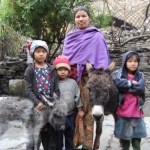
Sita K.G. already has one foal but keeps her donkeys together with another single mother’s donkey because the animal is pregnant and does not want to stay alone.
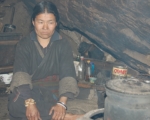
Nima T.
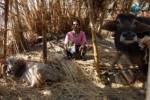
Paria P with her water buffaloes
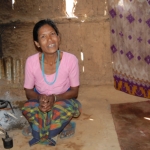
Paria P. at the entrance of the house she built herself
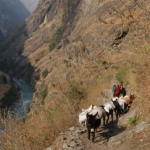
Single mothers from Eklaibhatti want to use their donkeys to transport goods for several days and share the income. In this sparsely populated region, all goods must be carried to the homes.
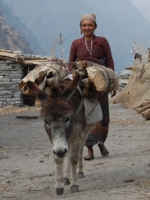
Maili G.
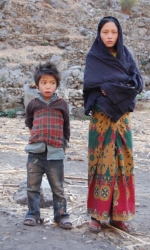
Sixteen year old Lushini G. looks after her nephew since his mother died when he was two months old.
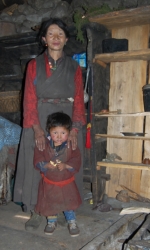
Nilta S. and her grandson live in an almost empty house.
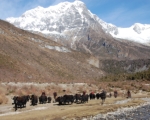
The women from Sama Gaon drive their naks to pasture.
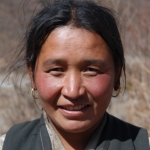
Tashi N.
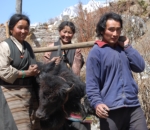
Transport of the injured yak calf
home | the project | news | on tour | on site | ideas | partners | the board | help | mail
Account No. 106 57575 - Sparkasse KölnBonn - BLZ 370 501 98
For donations from outside Germany - IBAN: DE02 3705 0198 0010 6575 75 - Swift-BIC: COLSDE33
please only bank transfers in Euro, no checks!